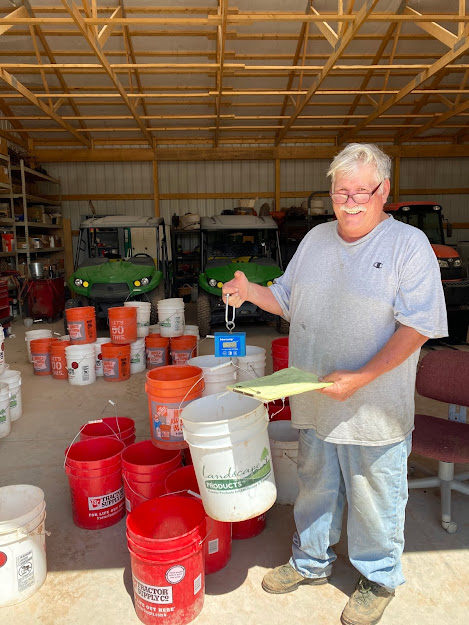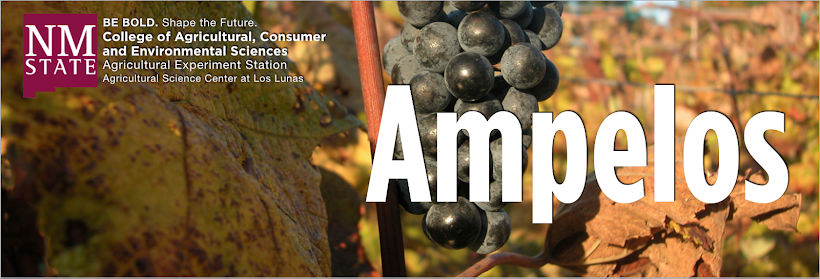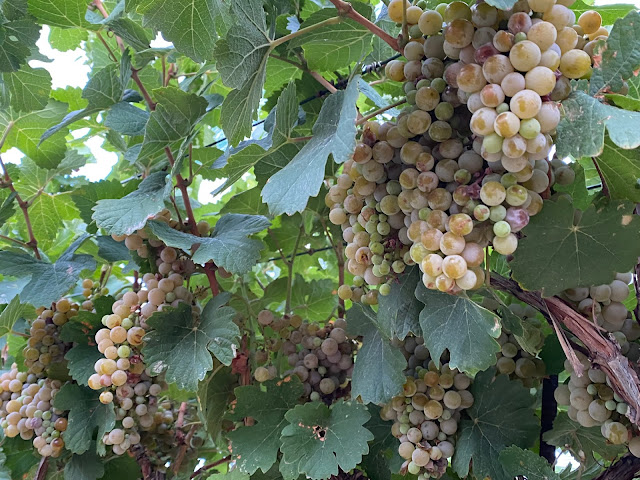
Friday, July 31, 2020
GRAPE AID 2020! VIVA VINO!

Montepulciano in New Mexico
Montepulciano at two New Mexico locations
 |
Black Mesa Vineyard and Winery, Velarde, NM, July 30, 2020 |
 |
Montepulciano at Black Mesa Vineyard, elev. ~ 5,700 ft. 36.17 N latitude, July 30, 2020 |
 |
Montepulciano at Las Cruces, NM, ~3,900 elev., 32.32 N latitude, July 31, 2020 |
Wednesday, July 29, 2020
Crop Estimation, Pinot noir clones and a teinturier variety with four seeds
Santa Ana Crop Estimation July 24, 2020
 |
| Here, Jim has completed his weighing of all the sample buckets...he then processed them to extract a juice sample to measure soluble solids (degrees Brix) and pH. |
 |
| Pinot noir clone 115, July 29, 2020 at Santa Ana Vineyard, NM |
 |
| Pinot noir clone 459, a high yielding clone, July 29, 2020, Santa Ana Vineyard, NM. |
 |
| Pinot noir clone 777, July 29, 2020, Santa Ana Vineyard, NM. |
 |
| Four seeds from a grape berry of Enchantment, a teinturier variety (colored pulp) developed at the University of Arkansas. This grape has Alicante Bouschet in its parentage. |
Tuesday, July 28, 2020
Pinot in Portales
Sunday, July 26, 2020
Retraining a winter/cold damaged vine
 |
| Fifteen year old 'Mission' vine with winter/cold damage. Regrowth from trunk and latent buds in evidence. Albuquerque Botanical Garden/Heritage Farm, June 19, 2020, Albuquerque, NM. |
 |
| 'Mission' grapevines on left and 'Glenora' grapevines on right. Albuquerque Botanical Garden/Heritage Farm, June 19, 2020, Albuquerque, NM. |
 |
| Close up of damaged, split vine trunk on the cultivar 'Mission' at Albuquerque Botanical Garden/Heritage Farm, June 19, 2020, Albuquerque, NM. |
July 26, 2020
NOTES: Retraining Cold Damaged Vines*
1. Replacing damaged trunks:
a. Multiple trunks spread risk of injury
b. Double trunks: leave spur to produce ‘replacement’ trunk
c. Following injury: some trunks die immediately and some die over 2-5 years
2. Bud numbers
a. Crop if possible to temper or tamp-down vegetative growth, without crop remaining and newly formed shoots will grow more vigorously
b. Leave compromised trunks if needed, to achieve bud numbers
3. Crown gall
a. No hurry to remove crown gall affected tissues, support trunk/bud numbers
b. Crown gall bacteria is already present systemically in the vine. Thus, no need to hurry to remove it. It can be pruned out next spring
4. Suckers
a. Growth from below ground, referred to as “suckers”
b. Suckers increase leaf area, part of vine’s ‘survival response’ to feed root system.
c. Sucker number increase when top growth (shoots and leaves) are damaged and missing. Top growth normally produces the hormone auxin. Auxin inhibits suckers from sprouting and growing. A proliferation of sucker growth at base of the vine indicates the vine has been injured …typically, from cold temperatures.
5. Cane size desired:
a. 7-9 mm, slightly diameter than a #2 pencil.
b. Larger diameter indicative of “bull” canes with excessive vegetative growth. Smaller diameter canes too weak for sufficient growth and support of healthy buds and crop.
6. Clean cuts
a. Dull pruner cuts look bad
b. Sloppy, tearing cuts, encourage wood rotting disease such as Eutypa
7. Training stakes
a. Place stake close to vine trunk and clip to cordon wire to hold it securely in place.
b. Stakes encourage straight trunks and benefit mechanization and vineyard operations in general.
8. Nitrogen and fertilizer application in year of recovery:
a. ~ 90% of vine’s N requirement is derived from reserves in woody tissues and soil nitrification
b. No need to fertilize winter/cold damaged vines as you retrain…skipping a year ok…unless obvious deficiencies present themselves…which is not likely.
* excerpted and summarized from:
Winter Injury to Grapevines and Methods of Protection, Extension Bulletin E2930, Michigan State University Extension, T. J. Zabadal, I. E. Dami, M.C. Goffinet, T.E. Martinson, M.L. Chien. 2007.
Saturday, July 25, 2020
Grants available, Healthy Soils Program from NMDA
Wednesday, July 22, 2020
Gewurztraminer harvest, and impact of inactivated yeast product on berry composition at Las Cruces, NM
Study of 'inactivated yeast products' on grape quality at Fabian Garcia, Agriculture Science Center
G. Giese1, Ciro Velasco-Cruz2, and D. Goodrich3
1 Asst. Professor, Extension Viticulture Specialist, New Mexico State University,
Department of Extension Plant Sciences, Los Lunas, NM 87031
2 Visiting Statistical Scientist, New Mexico State University, Department of Extension
Plant Sciences, Las Cruces, NM 87031, Research Professor, Estadistica, Colegio de
Posgraduados, Carretera Mexico-Texcoco Km. 36.5, Montecillo, Texcoco 56230,
Estado de Mexico, Mexico
3 Program Coordinator, New Mexico State University, Department of Extension Plant
Sciences, Las Cruces, NM 88003
Introduction and Potential Impact: Grapes grown in warm climates typically achieve desired sugar levels in advance of phenolic maturity (Gladstones, 2011). Furthermore, primary chemistry attributes: soluble solids, titratable acidity and pH, often ‘peak’ prior to development of many flavor and aroma precursors. Harvest decisions based on potential alcohol contingent on berry sugar level is not conducive to optimum wine quality. Tannins and anthocyanins are phenolic compounds essential for red wine color and astringency, considered essential to wine ‘quality’. Glutathione, is a thiol, a sulfur containing compound, that is important as an antioxidant and act to preserve aroma and color. It commonly occurs in aromatic white wine grapes.
Recently, foliar-applied nitrogen and inactivated yeast products have been tested for their impact on yield components and grape composition, and in some cases to evaluate their influence on free and bound volatiles.
Winegrowers in New Mexico seek to optimize berry composition and wine quality of grapes grown in a hot, arid environment. We evaluated the effects of a commercial “activated yeast” product (LalVigne Aroma and LalVigne Mature) on six established Vitis vinifera cultivars under the hot, arid climate conditions of southern New Mexico. This information will begin to clarify and quantify the potential benefit and economic feasibility of optimized berry and wine quality via foliar application of these products at a set crop load across several varieties.
Methods: The study was established in 2018 at the Fabian Garcia Agriculture Science Center in Las Cruces NM. Six Vitis vinifera varieties: Picpoul blanc, Gewürztraminer, Negro Amaro, Durif, Cabernet Sauvignon and Montepulciano (grafted to 101-14 rootstock, V. riparia x V. rupestris) The vineyard was planted in 2009 at a spacing of 4 ft x 10 ft. Each cultivar occurred in two rows, with one row trained to a modified VSP (vertical shoot positioned) trellis with a single pair of catch wires or and the second row trained to a single high-wire “sprawl” trellis system. All treatments were adjusted to a predetermined shoot/crop level of ~16 shoots/~32 clusters per vine, imposed when shoots reached ~10 cm length with 5 leaves separated and inflorescence clear (modified E-L stage 12, Coombe 1995) and cluster thinning imposed at E-L stage 27, fruit set). The experimental replicate plots consisted of four test vines arranged in GRCBD. Data collected included fruit yield, cluster and berry weight and composition (primary chemistry and either total phenolics (reds) or glutathione (whites)) and dormant pruning weights.
Results: Experimental treatments were initiated in the spring of 2018. We have collected various amounts of data in 2018 and 2019 and will complete the study this year, 2020.
References:
Bell, S. J., and P.A. Henschke. 2005. Implications of nitrogen nutrition for grapes, fermentation and wine. Aust. J. Grape and Wine Res., 11:242-295.
Coombe, B.G. 1995. Adoption of a system for identifying grapevine growth stages. Aust. J. Grape Wine Res. 1:104-110.
Gladstones, J. 2011.Wine, Terroir and Climate Change. Kent Town, Australia, Wakefield Press.
Jackson, D.I., and P.B. Lombard. 1993. Environmental and management practices affecting grape composition and wine quality – a review. Am. J. Enol. Vitic. 44:411-430.
Jackson, R.S. 2014.Wine Science Principles and Practices, 4th Edition, Academic Press, London.
Keller, M. 2010. The Science of Grapevines, Anatomy and Physiology. Academic Press, London.
 |
| Jacque Cormier, NMSU viticulture graduate student works to harvest Gewurztraminer at the Fabian Garcia ASC in Las Cruces, NM, July 22, 2020. |
Thursday, July 16, 2020
Enchantment and Opportunity
Two relatively new hybrids from University of Arkansas's fruit breeding program led by Dr. John Clark, are thriving in the experimental vineyard at NMUS's Los Lunas Agriculture Science Center.
 |
| 'Enchantment', a red hybrid winegrape from the University of Arkansas, in third leaf at the Los Lunas, Agriculture Science Center experimental vineyard, in Los Lunas NM, July 15, 2020. |
 |
| 'Opportunity', a white hybrid winegrape, from the University of Arkansas, in third leaf at the Los Lunas, Agriculture Science Center experimental vineyard, in Los Lunas NM, July 15, 2020. |
Wednesday, July 15, 2020
Veraison moves north....
 |
| Pinot noir enters veraison at Santa Ana vineyard in Sandoval County, north of Bernalillo, NM, July 14, 2020 |
Tuesday, July 14, 2020
Hemp in New Mexico and NMSU Farmington
 |
| Hemp variety trial at Farmington ASC, Notice the difference in plant form. |
Monday, July 6, 2020
Veraison 2020 arrives...
 |
| Flowering mix, that attracts beneficial insects? |
 |
| Bare ground or cultivated "control", note the sedge that is evident? |
 |
| Native vegetation * all photos courtesy of Jacqueline Cormier |
Saturday, July 4, 2020
New Mexico and western Texas and the southern Plains experienced a very dry month
Weather and Climate Summary and Forecast
July 2020 Report
Dr. Gregory Jones, Director of Wine Education, Linfield University in McMinnville Oregon, has released his latest compilation and report on weather for the western US, including New Mexico. Check out the full report at the link below, and sign up to receive direct emails from him regarding weather and climate that impacts your vineyard, farm or ranch. |
| US seasonal drought outlook HAPPY FOURTH OF JULY! |
Thursday, July 2, 2020
Yellow leaves explained...grapes aren't the only ones
To read more about iron chlorosis in plants in general go this link at NMSU
The following information is sourced directly from:
Keller, M. 2010., Environmental Constraints and Stress Physiology, In the Science of Grapevines, 262-264., Elsevier Inc., London, UK.
Iron, or Fe, the most abundant metal on Earth, is insoluble in oxygen rich environments, which include most soils. That first sentence should provide a clue to the condition of the vines in the photos with yellow leaves…but I encourage you to read on. Iron is also the most abundant micronutrient (a micronutrient is a nutrient needed in small amounts) in grape, and is a part of proteins and enzymes. It is needed to make chlorophyll, but is not found directly in the chlorophyll molecule. Iron is needed for photosynthesis, respiration, DNA synthesis and detoxifies oxygen species. It is found in leaves, seeds and pollen. Because it is part of pollen… think successful fruit set! Iron’s abundance in soil may contribute to inaccurate fertilizer recommendations, especially when leaf tissue samples, covered with soil “dust” are submitted to the lab for analysis.
Near the soil surface, where most plant roots including grape roots occur, oxygen is plentiful, and Fe occurs in the oxidized form Fe+3 (ferric iron). But it is the reduced form, Fe2+ or ferrous iron, that is soluble and able to be used by plants. Grapevines absorb iron “chelates”, which are, simply put, acidified forms that are more soluble and absorbable (see also: https://en.wikipedia.org/wiki/Chelation#Fertilizers)
After the Fe ions are moved from the soil into the root and xylem, they are transported as inactive Fe3+, and eventually arrive in the leaves and are reactivated to Fe2+ before the leaf mesophyll absorbs them. The protein that aids Fe absorption is sensitive to pH, and enzyme activity is reduced as pH increases (another clue to the yellow grape leaves in the photos). Once inside the plant cell, Fe is chelated again and distributed within the cell. Some of the cell’s iron is stored as ‘ferritin’, but 80% is in the chloroplast. Because iron is part of the chloroplast, when iron is deficient, photosynthesis, that is dependent on functioning chloroplasts and sugar production is sharply reduced. This lost photosynthesis and sugar production could have supported the developing fruit or shoot tips. Consequently, vine growth and yield are reduced and oxidative stress can be evident from excessive absorbed light. This oxidative stress is the reason for decline of leaf chlorophyll…and loss of the normal green color…voilà!
…yellow leaves!
Iron deficiency symptoms include leaf chlorosis, from loss of chlorophyll or lack of its production. This loss of green color or ‘chlorosis’ begins at the leaf margins and progresses to the interveinal area of young leaves, followed by marginal necrosis (death and browning of the leaf tissue) and finally abscission (leaf fall). Lateral shoots can be stunted, and can show pink internodes, and have small chlorotic leaves that fail to unfold. However, Fe is phloem mobile and move from older and senescing leaves. Tendrils and inflorescences can become chlorotic and fruit set is poor when deficiency is severe, as Fe is needed for pollen development.
Leaf chlorosis due to Fe deficiency develops frequently when grapes are grown on calcareous soils. Soils with abundant calcium occur in Burgundy, Champagne, eastern Washington, Hungary and New Mexico. Calcareous soils can contain sufficient Fe, but it is often in other chemical forms such as oxides and hydroxides that roots cannot absorb. A one-unit increase in soil pH can decrease solubility of Fe 1000-fold (see Figure 1).
Figure 1. Nutrient availability dependent on soil pH. Notice the sharp drop in Iron availability from pH 7.0 to 8.0?
Dr. Keller (see REF. above) points out that diagnosis of Fe chlorosis by tissue analysis is often confounded or is difficult because the amount of Fe determined in chlorotic leaves by tissue analysis is often similar or greater, than levels of Fe measured in ‘healthy’ leaves. This result is partially due to the physically smaller Fe deficient leaves, and the fact that not all Fe measured in a leaf is physiologically active.
The ability of vines to cope with this conundrum of abundant but unavailable, insoluble Fe, depends on where the plant species evolved. Vitis vinifera, the European grape, that evolved in calcareous soils, has the ability to pump out H+ and organic acids from its roots that acidify the soil and causes Fe to become soluble and ready for uptake. Vitis labrusca , think Concord, on the other hand, evolved mostly in acidic soils and do not have this level of “acid pump” mechanism capability in their roots. This H+ release “strategy” works only for species that evolved in high pH soils.
As further explanation…the vine takes up bicarbonate, HCO3-, which comes from the CaCO3 in calcareous soils. The bicarbonate affects the cell’s apoplast (the apoplast is the space outside the plant cell…between plant cells) and the apoplast is inhibited from converting Fe to its plant active form. This results in the Fe being “locked up” in the apoplast, it does not enter the leaf mesophyll, and cannot be metabolized. Finally, without Fe metabolism, the leaf turns yellow (remember that Fe is part of the green chloroplast and without it …there is no green, or much reduced green color). More specifically, there is yellowing between the veins (take a look at the photos to see evidence of this) of young leaves and eventually the whole leaf whitens. Leaves continue to signal the roots to take up more iron…and the total leaf Fe concentration is actually increased while the leaf is yellowing!
This “iron-chlorosis” or “lime-induced” paradox is common in own-rooted Concord vines that you can see in the photos. Such V. labrusca type vines prefer soil pH closer to 5.5…while many New Mexico soils range from 7.0 to 8.5. But the condition should more accurately be referred to as “bicarbonate-induced” chlorosis. Compacted and water-logged soils can exacerbate the problem…but the latter are not common in New Mexico vineyards.
Although rare, Fe toxicity can also cause oxidative stress, reduced chlorophyll and result in chlorotic leaves. However, Fe toxicity is very rare, typically occurs on acid soils, and/or as a result of excess application of foliar nutrient sprays…from incorrect applicator calculations.








